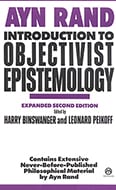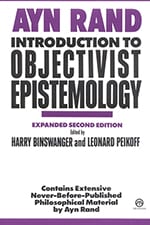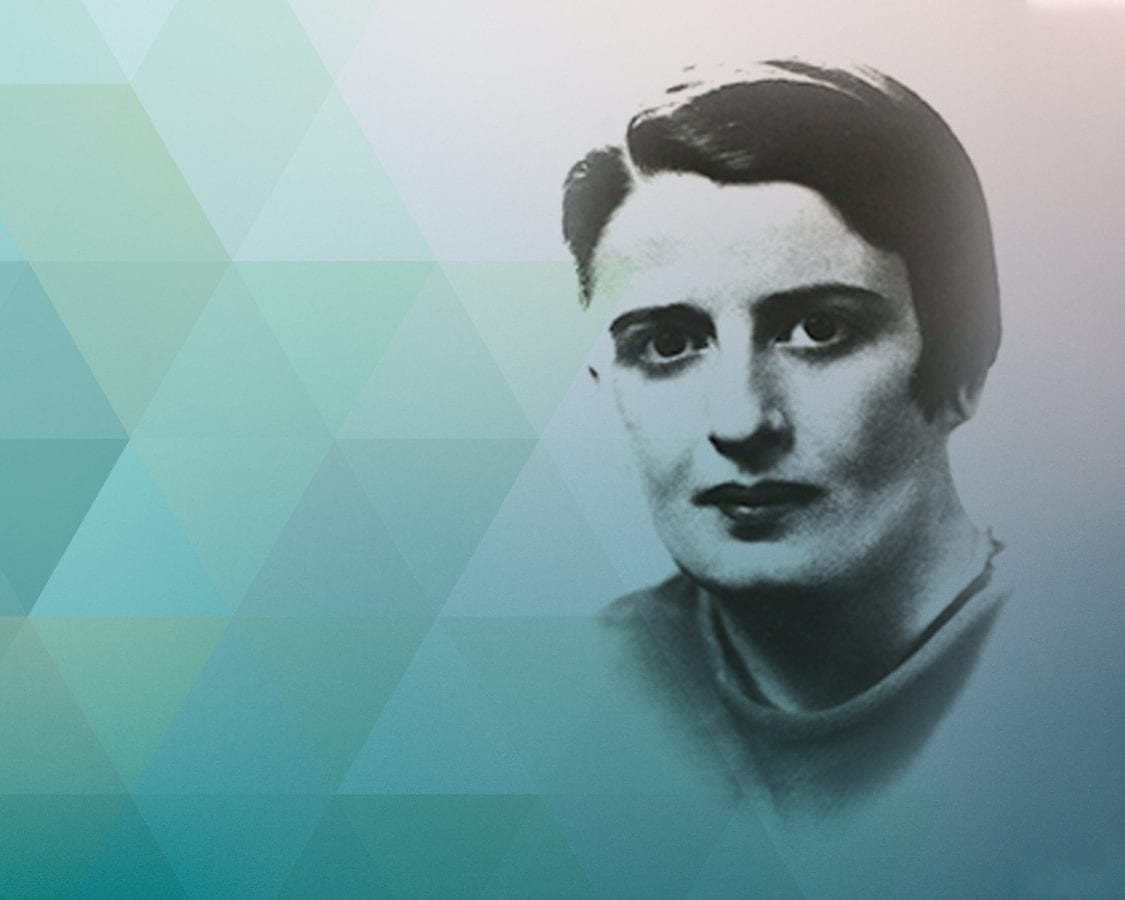“Axiomatic Concepts,” which is chapter 6 of Introduction to Objectivist Epistemology, was first published in the December 1966 issue of The Objectivist, then in a booklet containing the entire work (1967), then in a mass market paperback (1979) and most recently in an expanded second edition (1990).
Axioms are usually considered to be propositions identifying a fundamental, self-evident truth. But explicit propositions as such are not primaries: they are made of concepts. The base of man’s knowledge — of all other concepts, all axioms, propositions and thought — consists of axiomatic concepts.
An axiomatic concept is the identification of a primary fact of reality, which cannot be analyzed, i.e., reduced to other facts or broken into component parts. It is implicit in all facts and in all knowledge. It is the fundamentally given and directly perceived or experienced, which requires no proof or explanation, but on which all proofs and explanations rest.
The first and primary axiomatic concepts are “existence,” “identity” (which is a corollary of “existence”) and “consciousness.” One can study what exists and how consciousness functions; but one cannot analyze (or “prove”) existence as such, or consciousness as such. These are irreducible primaries. (An attempt to “prove” them is self-contradictory: it is an attempt to “prove” existence by means of nonexistence, and consciousness by means of unconsciousness.)
Existence, identity and consciousness are concepts in that they require identification in conceptual form. Their peculiarity lies in the fact that they are perceived or experienced directly, but grasped conceptually. They are implicit in every state of awareness, from the first sensation to the first percept to the sum of all concepts. After the first discriminated sensation (or percept), man’s subsequent knowledge adds nothing to the basic facts designated by the terms “existence,” “identity,” “consciousness” — these facts are contained in any single state of awareness; but what is added by subsequent knowledge is the epistemological need to identify them consciously and self-consciously. The awareness of this need can be reached only at an advanced stage of conceptual development, when one has acquired a sufficient volume of knowledge — and the identification, the fully conscious grasp, can be achieved only by a process of abstraction.
It is not the abstraction of an attribute from a group of existents, but of a basic fact from all facts. Existence and identity are not attributes of existents, they are the existents. Consciousness is an attribute of certain living entities, but it is not an attribute of a given state of awareness, it is that state. Epistemologically, the formation of axiomatic concepts is an act of abstraction, a selective focusing on and mental isolation of metaphysical fundamentals; but metaphysically, it is an act of integration — the widest integration possible to man: it unites and embraces the total of his experience.
The units of the concepts “existence” and “identity” are every entity, attribute, action, event or phenomenon (including consciousness) that exists, has ever existed or will ever exist. The units of the concept “consciousness” are every state or process of awareness that one experiences, has ever experienced or will ever experience (as well as similar units, a similar faculty, which one infers in other living entities). The measurements omitted from axiomatic concepts are all the measurements of all the existents they subsume; what is retained, metaphysically, is only a fundamental fact; what is retained, epistemologically, is only one category of measurement, omitting its particulars: time — i.e., the fundamental fact is retained independent of any particular moment of awareness.
It must be remembered that conceptual awareness is the only type of awareness capable of integrating past, present and future. Sensations are merely an awareness of the present and cannot be retained beyond the immediate moment; percepts are retained and, through automatic memory, provide a certain rudimentary link to the past, but cannot project the future. It is only conceptual awareness that can grasp and hold the total of its experience — extrospectively, the continuity of existence; introspectively, the continuity of consciousness — and thus enable its possessor to project his course long-range. It is by means of axiomatic concepts that man grasps and holds this continuity, bringing it into his conscious awareness and knowledge. It is axiomatic concepts that identify the precondition of knowledge: the distinction between existence and consciousness, between reality and the awareness of reality, between the object and the subject of cognition. Axiomatic concepts are the foundation of objectivity.
Axiomatic concepts identify explicitly what is merely implicit in the consciousness of an infant or of an animal. (Implicit knowledge is passively held material which, to be grasped, requires a special focus and process of consciousness — a process which an infant learns to perform eventually, but which an animal’s consciousness is unable to perform.)
If the state of an animal’s perceptual awareness could be translated into words, it would amount to a disconnected succession of random moments such as “Here now table — here now tree — here now man — I now see — I now feel,” etc. — with the next day or hour starting the succession all over again, with only a few strands of memory in the form of “This now food” or “This now master.” What a man’s consciousness does with the same material, by means of axiomatic concepts, is: “The table exists — the tree exists — man exists — I am conscious.”
(The above projection of an animal’s awareness is what certain modern philosophers, such as logical positivists and logical atomists, ascribe to man, as his start and his only contact with reality — except that they reject the concept “reality,” substitute sensations for percepts, and regard everything above this sub-animal level as an arbitrary human “construct.”)
Since axiomatic concepts are not formed by differentiating one group of existents from others, but represent an integration of all existents, they have no Conceptual Common Denominator with anything else. They have no contraries, no alternatives. The contrary of the concept “table” — a non-table — is every other kind of existent. The contrary of the concept “man” — a non-man — is every other kind of existent. “Existence,” “identity” and “consciousness” have no contraries — only a void.
It may be said that existence can be differentiated from non-existence; but non-existence is not a fact, it is the absence of a fact, it is a derivative concept pertaining to a relationship, i.e., a concept which can be formed or grasped only in relation to some existent that has ceased to exist. (One can arrive at the concept “absence” starting from the concept “presence,” in regard to some particular existent(s); one cannot arrive at the concept “presence” starting from the concept “absence,” with the absence including everything.) Non-existence as such is a zero with no sequence of numbers to follow it, it is the nothing, the total blank.
This gives us a lead to another special aspect of axiomatic concepts: although they designate a fundamental metaphysical fact, axiomatic concepts are the products of an epistemological need — the need of a volitional, conceptual consciousness which is capable of error and doubt. An animal’s perceptual awareness does not need and could not grasp an equivalent of the concepts “existence,” “identity” and “consciousness”: it deals with them constantly, it is aware of existents, it recognizes various identities, but it takes them (and itself) as the given and can conceive of no alternative. It is only man’s consciousness, a consciousness capable of conceptual errors, that needs a special identification of the directly given, to embrace and delimit the entire field of its awareness — to delimit it from the void of unreality to which conceptual errors can lead. Axiomatic concepts are epistemological guidelines. They sum up the essence of all human cognition: something exists of which I am conscious; I must discover its identity.
The concept “existence” does not indicate what existents it subsumes: it merely underscores the primary fact that they exist. The concept “identity” does not indicate the particular natures of the existents it subsumes: it merely underscores the primary fact that they are what they are. The concept “consciousness” does not indicate what existents one is conscious of: it merely underscores the primary fact that one is conscious.
This underscoring of primary facts is one of the crucial epistemological functions of axiomatic concepts. It is also the reason why they can be translated into a statement only in the form of a repetition (as a base and a reminder): Existence exists — Consciousness is conscious — A is A. (This converts axiomatic concepts into formal axioms.)
That special underscoring, which is of no concern to animals, is a matter of life or death for man — as witness, modern philosophy, which is a monument to the results of the attempt to evade or bypass such reminders.
Since axiomatic concepts refer to facts of reality and are not a matter of “faith” or of man’s arbitrary choice, there is a way to ascertain whether a given concept is axiomatic or not: one ascertains it by observing the fact that an axiomatic concept cannot be escaped, that it is implicit in all knowledge, that it has to be accepted and used even in the process of any attempt to deny it.
For instance, when modern philosophers declare that axioms are a matter of arbitrary choice, and proceed to choose complex, derivative concepts as the alleged axioms of their alleged reasoning, one can observe that their statements imply and depend on “existence,” “consciousness,” “identity,” which they profess to negate, but which are smuggled into their arguments in the form of unacknowledged, “stolen” concepts.
It is worth noting, at this point, that what the enemies of reason seem to know, but its alleged defenders have not discovered, is the fact that
Observe the fact that in the writings of every school of mysticism and irrationalism, amidst all the ponderously unintelligible verbiage of obfuscations, rationalizations and equivocations (which include protestations of fidelity to reason, and claims to some “higher” form of rationality), one finds, sooner or later, a clear, simple, explicit denial of the validity (of the metaphysical or ontological status) of axiomatic concepts, most frequently of “identity.” (For example, see the works of Kant and Hegel.) You do not have to guess, infer or interpret: they tell you. But what you do have to know is the full meaning, implications and consequences of such denials — which, in the history of philosophy, seem to be better understood by the enemies of reason than by its defenders.
One of the consequences (a vulgar variant of concept stealing, prevalent among avowed mystics and irrationalists) is a fallacy I call the Reification of the Zero. It consists of regarding “nothing” as a thing, as a special, different kind of existent. (For example, see Existentialism.) This fallacy breeds such symptoms as the notion that presence and absence, or being and non-being, are metaphysical forces of equal power, and that being is the absence of non-being. E.g., “Nothingness is prior to being.” (Sartre) — “Human finitude is the presence of the not in the being of man.” (William Barrett) — “Nothing is more real than nothing.” (Samuel Beckett) — “Das Nichts nichtet” or “Nothing noughts.” (Heidegger). “Consciousness, then, is not a stuff, but a negation. The subject is not a thing, but a non-thing. The subject carves its own world out of Being by means of negative determinations. Sartre describes consciousness as a ‘noughting nought’ (néant néantisant). It is a form of being other than its own: a mode ‘which has yet to be what it is, that is to say, which is what it is, that is to say, which is what it is not and which is not what it is.’ ”(Hector Hawton, The Feast of Unreason, London: Watts & Co., 1952, p. 162.)
(The motive? “Genuine utterances about the nothing must always remain unusual. It cannot be made common. It dissolves when it is placed in the cheap acid of mere logical acumen.” Heidegger.)
A man’s protestations of loyalty to reason are meaningless as such: “reason” is not an axiomatic, but a complex, derivative concept — and, particularly since Kant, the philosophical technique of concept stealing, of attempting to negate reason by means of reason, has become a general bromide, a gimmick worn transparently thin. Do you want to assess the rationality of a person, a theory or a philosophical system? Do not inquire about his or its stand on the validity of reason. Look for the stand on axiomatic concepts. It will tell the whole story.






